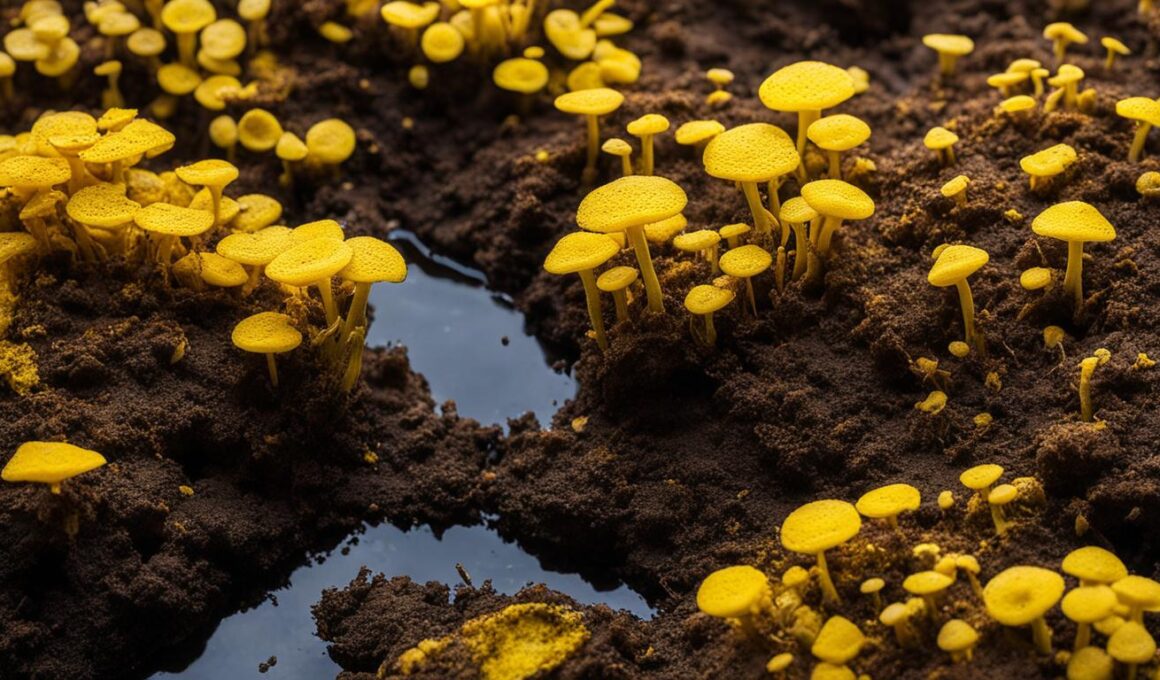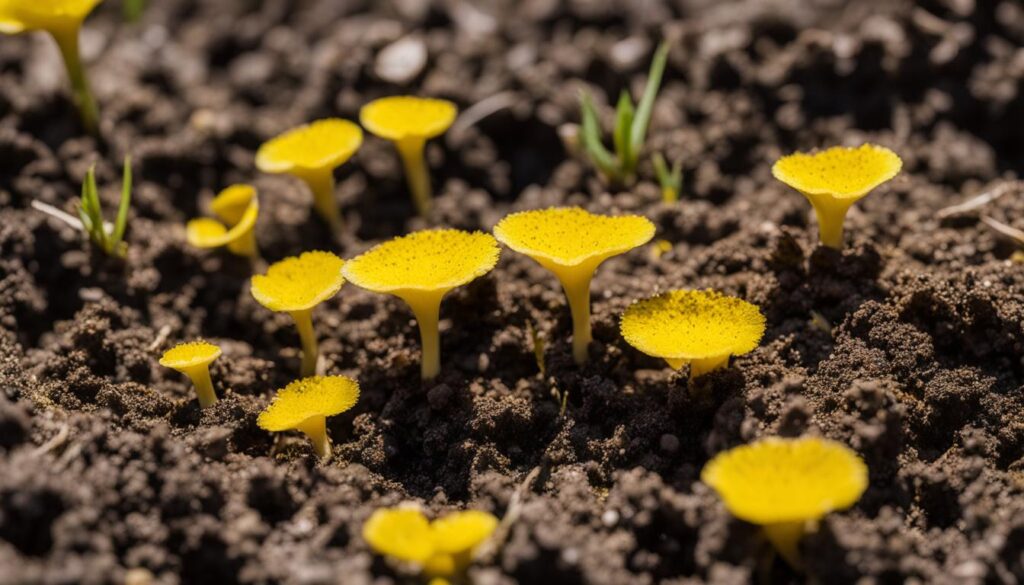Welcome to an informative guide on yellow fungus in soil and how it can affect your garden. Discover remedies and prevention methods to keep your plants healthy and thriving.
Yellow fungus in soil can be a worrisome sight, but not all types are harmful to your garden. One common yellow fungus found in soil is Leucocoprinus birnbaumii. This fungus, while harmless to plants, can be toxic to people and animals. It is crucial to remove the mushrooms if they appear, especially if you have pets or small children around.
Although fungicide treatments are generally ineffective against mushrooms, there are ways to prevent yellow fungus in soil. By implementing preventive measures, you can maintain the health and vibrancy of your garden.
Stay tuned for the following sections where we will discuss how to identify yellow fungus in soil, effective methods for dealing with it, and the importance of proactive prevention. Let’s get started!
Identifying Yellow Fungus in Soil
Yellow fungus in soil can take different forms, including small yellow mushrooms. The most common type of yellow fungus found in soil is called Leucocoprinus birnbaumii. These mushrooms are usually lemon yellow in color and can range from 1 to 3 inches tall with oval or bell-shaped caps. They may appear singly or in clusters. Leucocoprinus birnbaumii is commonly found in flowerpots, greenhouses, and warm, humid climates. While these mushrooms may be concerning, they are actually a sign of healthy soil and do not harm the plants. However, it is important to note that they are not edible and may be toxic to humans and animals.
Yellow fungus in soil can be visually striking, as seen in the image above. However, it’s crucial to be aware of its nature and take appropriate precautions.
Dealing with Yellow Fungus in Soil
While yellow fungus in soil is generally harmless to plants, it is important to address the issue to maintain a healthy garden. Here are some tips for dealing with yellow fungus in soil:
- Prevention is key: One of the best ways to deal with yellow fungus in soil is to prevent its occurrence in the first place. Ensure proper garden hygiene by regularly removing dead leaves, plant debris, and excess water. Avoid over-watering your plants as it can create a favorable environment for the fungus to thrive.
- Improve soil drainage: Yellow fungus thrives in excessively damp soil. To prevent its growth, make sure your garden soil has good drainage. Add organic matter such as compost or peat moss to improve soil structure and enhance water absorption.
- Aerate the soil: Aerating the soil helps improve airflow and reduces moisture retention, making it less favorable for yellow fungus growth. Use a garden fork or aerator to create small holes in the soil, allowing better oxygen circulation.
- Apply fungicidal remedies: If you notice yellow fungus in your soil, you can use fungicidal remedies to control its spread. Look for fungicides specifically designed for soil-borne diseases and follow the instructions on the label for application.
- Use natural remedies: Alternatively, you can opt for natural remedies to combat yellow fungus. Neem oil, baking soda solutions, or hydrogen peroxide diluted with water can be effective in suppressing fungal growth. Apply these remedies to the affected areas of the soil as per the instructions.
- Remove and replace affected soil: In severe cases of yellow fungus infestation, it may be necessary to remove and replace the affected soil. Dig out the contaminated soil and replace it with fresh, healthy soil. This will help eliminate the source of the fungus and prevent further spread.
Remember, prevention is key when it comes to dealing with yellow fungus in soil. By maintaining proper garden hygiene, improving soil drainage, and taking proactive measures, you can keep your plants healthy and free from yellow fungus.
Conclusion
In conclusion, yellow fungus in soil may initially raise alarms, but it’s important to understand that not all types of yellow fungus are harmful to your plants. The most common type, Leucocoprinus birnbaumii, actually plays a beneficial role by breaking down dead organic matter, indicating healthy soil. While it is crucial to remove the mushrooms if they appear and take preventive measures such as ensuring proper airflow and drainage in your garden, there are natural remedies and soil replacement options available to control yellow fungus.
To keep your garden healthy and vibrant, staying proactive is essential. By taking appropriate actions, such as removing mushrooms, improving soil conditions, and implementing preventive measures, you can effectively manage yellow fungus in your soil. Maintaining a balance between moisture and airflow, using organic fungicides, and regularly monitoring your plants for any signs of yellow fungus will help you prevent its recurrence and keep your garden thriving.
Remember, prevention is key when it comes to yellow fungus in soil. By implementing these remedies and continually monitoring the health of your garden, you can ensure a thriving environment for your plants while minimizing the risk of yellow fungus development. By following these guidelines and taking care of your garden, you can create a beautiful and healthy outdoor space for yourself and your loved ones to enjoy.
Are the Remedies for Yellow Mold in Soil the Same as for Yellow Fungus in Soil?
When dealing with the causes of yellow mold in soil, it’s important to note that the remedies for yellow mold and yellow fungus in soil are not necessarily the same. While both may involve improving drainage and reducing moisture, specific treatment methods may vary. Consulting a garden expert is advised for tailored solutions.
Source Links
- https://www.ehow.com/facts_7866741_yellow-fungus-top-soil.html
- https://hortnews.extension.iastate.edu/faq/one-my-houseplants-has-small-yellow-mushrooms-surface-potting-soil-will-mushrooms-harm-it
- https://www.lovethatleaf.co.nz/blogs/plant-care-guides/yellow-mushrooms-in-your-indoor-plants-when-to-worry-and-what-to-do








